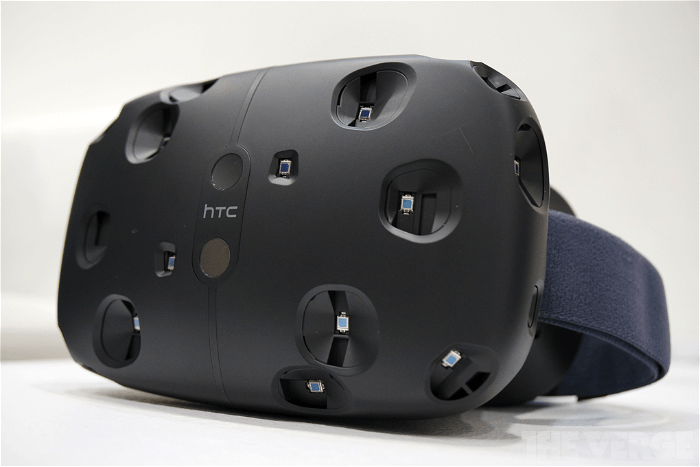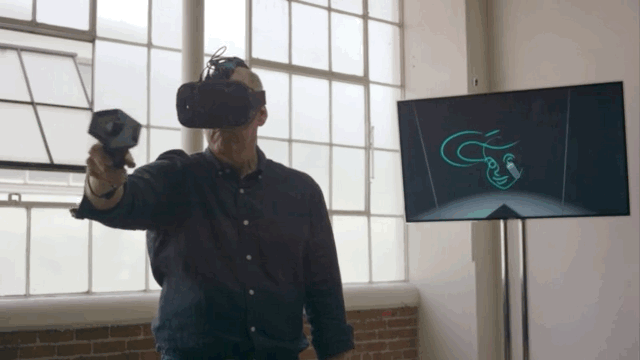Gaming is constantly evolving, trying to provide a more engaging and more immersive experience. Limitations of the medium have restricted immersion to remain mostly in the realms of storytelling and character engagement. Which is in no way a bad thing, but personally, I’ve wanted TRON to be a real thing for almost my whole life. Long have I waited for the day of a truly immersive game; one that actually puts you in the game world. It seems that day may be upon us, as CGM sat down with Senior Manager, Product Marketing at HTC, JB McRee to talk about the new VR platform created by HTC in partnership with Valve.

CGMagazine: So tell us a bit about the HTC Vive.
JB: So, the main difference between HTC Vive and all other VR systems is what we call “Room Scale VR,” it’s the biggest differentiator. So Room Scale VR means that instead of being seated or standing, what you can do with Vive, you have the ability to walk around the virtual world. So up to a 15 by 15 foot space is kind-of your stage to explore. So, inside the virtual environment, if you step left and step right, your perspective changes. If you duck down, your perspective changes. So that is, the term in VR is “presence”; presence is basically the physical and mental immersion to the experience. So being able to move around naturally is a presence multiplier. We also have positional tracked controllers that are wireless in design, specifically for VR interaction. Those are also presence multipliers. When you’re using your controllers to do actions and the virtual world is responding, it feels very natural.
So you can imagine if you’re playing a game and using your controller, it does things like make you go forwards and backwards. But in a virtual world, when it’s something new to you, and in order for you to move forward, you’re not having to think about “what command do I give the controller?” You’re actually doing what comes naturally by stepping. You become, subconsciously, more into the experience.

CGMagazine: Now how does that play out then for a market experience? Like, if a guy like me wanted to get this and play it in his room, and have that same experience, but now there’s a bed and a dresser and obstacles everywhere. Is the Vive going to be designed for that, or if you want it, you have to set yourself up in a big empty room?
JB: You can use this as seated or standing with one tracking station or two. One tracking station, seated is fine. Two tracking stations provides the best experience so that you can turn your back to one and you’re still being tracked by the other one. In a seated experience, you just need that small space. But if you want to use room scale, you need a space about the size of two yoga mats, up to 15 by 15 feet. Down the road, future iterations—ie. non-developer iterations—what comes next, we’ll take into consideration static environments, like tables and chairs and those things as well, as dynamically changing environments, things like cats and kids that may enter the room. You’ll be able to recognize those things as they’re happening around you so you don’t get into a situation where it messes with the experience.
In order to take advantage of room scale the most, you want to have the largest space possible with the least amount of objects in the way. But you can use it in a smaller experience, or smaller area, and we’re kind of leaning on the developers to figure out how content scales so that if you have a five by five space, and I have a 10 by 10, our content will scale to fit appropriately and be just as immersive for you as it is for me. And part of the setup and configuration is configuring your room. So what we have is called the ‘chaperone’, and much like a chaperone on a field trip, the job is to keep you safe. So you configure your chaperone to recognize where things are. So as you approach objects like the wall, it’ll pop up a grid and let you know that there’s a wall there. So it’s not very intrusive to you and not very distracting when you’re in the experience.

CGMagazine: What then will separate this from something like the Oculus or the Samsung VR.
JB: Well, there’s a couple of different ways to think about it. You can think about it like quality tiers, per-say. So you’ve got your entry level, very accessible things like Google Cardboard. Then you move to something like the Gear VR which still uses a phone but much more premium, higher fidelity experience.
And then you get into console-based VR, which is going to be PlayStation Morpheus, and one of the things there is that you’re somewhat limited by the capabilities of the hardware inside of the PlayStation. You can’t actually expand and make the PlayStation more powerful to give you a more immersive experience. It’s going to be the best it can for the hardware that’s inside that system.
And then you have PC-powered VR, which is Oculus and HTC. It’s the highest fidelity, most premium, most immersive experience possible. But what separates us from Oculus is the Room Scale. And so, from a resolution perspective, and refresh rate and latency perspective, Oculus and HTC are very similar, but what sets us apart is the ability to move around and explore the virtual world.

CGMagazine: Is the HTC going to eventually branch off into more multimedia? I know the Gear VR is going to have the whole Netflix virtual living room. I know Steam doesn’t really specialize in that, but is it an avenue that might be pursued in the future?
JB: We’re going to announce stuff later in the year that will reveal more information about the types of different areas that we’re looking into, but I think the goal would be to have the largest content library possible and the coolest and most unique content possible. And it’s likely that you’ll find certain content coming from certain places. Let’s say, for example, there’s a YouTube VR; it’s likely that everybody who can plug into that is going to plug into that. So even though it’s not on Steam, if something like that did come to market, it would, hopefully, be able to be integrated within all the systems.
CGMagazine: What’s your biggest or most ambitious idea, or project that you’d like to see on the Vive?
JB: It’s really tough to say. Nobody really knows what that cool, unique thing is going to be. I think the interesting thing to note about HTC in general is, we are in no way being prescriptive to the developers that have the units. We and Valve are working together to distribute these units out to developers who are capable of creating compelling content. And we are in no way being prescriptive on what they need to create; we’re letting them do whatever they want because they’re the experts. It’s interesting that the people who have the capability of creating compelling content inside a virtual environment currently exist in gaming. So as that framework starts to get developed, you’re going to see other areas like entertainment, media, and design; all these people trying to come in and learn the structure and architecture of creating that content, and then you’ll see content expand into other areas. But we as company are not trying to tell people what they need to do and the hope is that they are going to be creating this. We have a team of producers to help work with them along the way and ensure they have the tools they need to create what they want to create.




